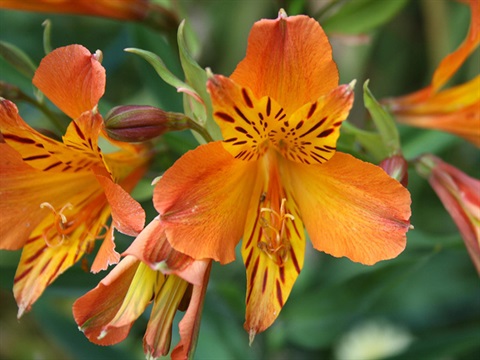Peruvian Lily

Alstroemeria auria
Origin: Peru, Chile, Tropical America
Size: 1m high
Best removal time: September to March
Flowers: October to February (Summer)
What it does
Peruvian Lily smothers and displaces indigenous grasses and ground covers and prevents bush regeneration. It prefers moist, well-composted, well-drained soil in a sunny position. Peruvian Lily is a perennial plant, its stem is erect and flowering.
What it looks like
It has numerous unbranched leafy stems arising annually from tuberous roots and spreading underground stems and its leaves are alternately arranged, Flowers (4-5cm across), with parts differing in shape and size, are in loose clusters at the tops of stems. The fruit is capsule. Leaves are oblong to lance-shaped and flowers are golden yellow to orange with reddish-brown streaks on the back pair of petals. Can be locally abundant in gullies and shady, moist sites.
How it spreads
- by seed or root division, wildly spreading.
Removal
Remove by Hand
It is important to remove all roots from beneath the soil. Alternatively cut the flower heads before seeding to help prevent spreading. Brush cutting can be done regularly.
Dig out
Ensure that all root material is removed when digging out. It is important to avoid dumping the removed plants and roots on your property as this will distribute the weed further. The area should be monitored for any regrowth.
Indigenous alternatives to plant
Many groundcover alternatives exist that are indigenous to the Yarra Ranges region and would make great substitutes for the Peruvian Lily.
How to dispose of weeds
By disposing of environmental weeds correctly you can prevent re-infestation on your property and elsewhere.
- Landfill (Weed Wipeout Tip vouchers available for some species).
- Green waste bins ensure that weeds are not able to spread.
- Woody weed stems can be bundled for green collection twice per annum.
- Composting (excluding seed heads or species with vegetative reproduction, e.g. Wandering Trad).
- Burning in accordance with Council and the Country Fire Authority (CFA) prescribed burning periods and regulations.
- Recovery and transfer stations available for weed tipping are Healesville, Wesburn, Coldstream, Lysterfield and Montrose.
Using chemicals
Non-chemical treatment is often the most effective and safe option especially on smaller scale infestations.
Where chemical use is undertaken:
- Always follow the manufacturer’s guidelines when using chemicals.
- Wear protective clothing and eyewear.
- When purchasing your herbicide, always ask for a Materials Safety Data Sheet (MSDS) or refer to the manufacturer’s website for specific safety guidelines and information.
- Some herbicides will kill other plants and not just the target species.
- When used near waterways herbicides can be very poisonous to aquatic life.
- Use chemicals sparingly and be sure that you are using the right chemical and application technique.
- Ensure the weather conditions are suitable (e.g. minimal wind and no rain expected).
- Apply herbicides at the correct time during the plant’s growth cycle so you get the best results.